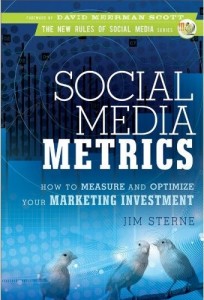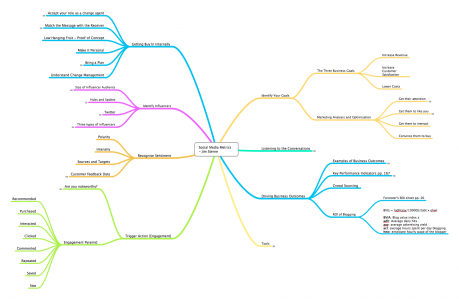Social Media Metrics by Jim Sterne
Recently I ordered a stack of books from Amazon.com around three topics of interest – one of which was Social Media.The shipment arrived in the brown box with red and white adhesive tape labelled “Aramex”.
Jim Sterne’s Social Media Metrics is the first of the books on Social Media. I will go into some level of detail but for the casual readers, here is a quick appraisal of the book and its contents:
Pros.
- Minimalistic content and progressive – building up ideas gradually.
- Objective approach focusing on metrics rather than trying to convince the audience of a moot point; that social media matters.
- Lists metrics by topic and sometimes offers tools to measure performance
- Provides useful references and tools for measure specific archetypes of social media; such as microblogs or blogs.
- Provides a bibliography and an appendix of useful links.
- Identifies key issues every marketing manager will run into:
- Convincing colleagues in all their flavours: from executives to developers.
- In any social campaign, there is a significant need for change management
- Key Performance Indicators (KPIs) have to translate into business outcomes – and therefore align with the organisations’marketing strategy
- Entertaining read – very cynical and sarcastic. If not for anything else, pick up this book to have a good laugh at the gung-ho attitude Sterne’s rhetoric
While I appreciate the effort the author made in compiling useful content and presenting in a single book; style, grammar and coherency were totally lacking. I found myself cringing as my eyes passed over almost every word.
Cons.
- Poor delivery of some good ideas – poor grammar, poor spelling, a lack of coherency, an inconsistent style of writing, haphazard referencing. I found myself flipping back a few pages to check if I was still reading about the same concept or if I had skipped a few chapters.
- Sterne beats around the bush on several topics – crowd sourcing for example – and often fails to give an interesting concept enough real estate. The book is full of references to literature, online resources, and articles but on a topic as important as change management the only advice Sterne has to offer is: “Read a book”.
- This book could have been written with a lot less words [but would probably be a lot less entertaining]
- A lot of the material is referenced, repurposed, and regurgitated. This makes me question if there is any value added content in this book at all – certainly, all the concepts in this book can be found through Google … for free.
Right so that’s the laundry list of positives and negatives. The bottom line is that this book provides a good kick off point for marketing managers who have already accepted the importance of social media, appreciate a need to measure performance on social media, but have no clue about what sort of metrics are applicable.
The book, however, will not give you a sword and shield that you can take into the executive board room and battle for a budget to execute your next big social media campaign. The book will however tell you that you need a sword and shield … and the sword has to be ironclad … and the shield need bullet and dragon-breath proof … then will wish you good luck on your adventure.
Would I recommend the book – yes.
Would I use this book as a reference tool to measure a campaign launch – no.
Summary of Concepts
You can click on the thumbnail to download a simplified mind map of the core concepts in this book. You can optionally click here to download the entire map in detail – the image is approximately 1.3 megabytes. Each node and the value from each concept will briefly be discussed.
Identify your goals
There are three main goals to any social media effort:
- Increase Revenue
- Increase Customer Satisfaction
- Reduce Costs
In juxtaposition, Sterne offers a four step approach to realizing these goals:
- Get your customers attention and measure it:
- Build customer sourced positive reinforcement for your brand
- Engage and interact with your customers
- Create incentive to increase goal oriented behaviour
These steps not special to social media, but are a prerequisite to any time based project. Identify your objectives and execute against those goals. It seems simple enough, but more often than not managers will miss a step and fumble.
I have some contention around the order of the approach – how can you get your customers to like you before engaging them? Sterne separates each step and does not provide insight on how to transition between each phase.
Identify Influencers
Sterne offers three categories of influences:
- Key Influencers: typically have a large fan following, own blogs, and can influence the purchasing decisions of participants on the social sphere. Ansam518.com and 248am.com spring to mind.
- Social Influencers: those who are active on social platforms and can affect brand affinity.
- Known Peer Influencers: those who are closest to the customer and can influence the buying decision. You wife or your best friend.
I quite like this taxonomy, it especially helps when analysing your networks. Sterne also touches on hubs and spokes of a network of relationships. Mapping relationships is more insightful when trying to identify impact than counting the sheer number of followers.
Listen to Conversations
Sterne identifies key areas in the social sphere to monitor and research:
- Search – both on Search Engines and Internal Search
- Comments
- Reviews
What to look for in mining data:
- Complaints
- Contributions
- Customer Service Opportunities
It is also important to measure business outcomes from the monitoring exercises you undertake. How many ideas were implemented from a contribution on a social media channel? What was the revenue that idea generated? That revenue should be attributed to social media management.
Sterne details 8 degrees of listening an organizations evolves through:
- Not objective.
- Tracking mentions
- Identifying risks and opportunities
- Improving campaign efficiency
- Measuring customer satisfaction
- Responding to inquiries
- Better understand customers
- Proactive and anticipate reactions
Recognize Sentiment
Sterne suggests that sentiment is probably the most complex item to measure and is made up of three variables:
- Polarity – 🙂 vs. 🙁
- Intensity – 🙂 vs. ^___^
- Sources and Targets – a tantrum or a genuinely affected customer sharing a poor service experience via a blog
Sterne offers some insight into measuring sentiment and provides various tool. Perhaps the most useful reference Sterne provides is a link to Seth Godin’s article “When will they make fun of you?.
I recommend everyone takes a look at it. If I had a fils for every time I met an executive afraid of engaging in social media because the prospects of a poor review were daunting.
Trigger Actions
Triggering action is concerned with engaging customers wide and deep. The degree of engagement offered by stern is rudimentary at best but delivers the message – some people are more involved than others and its your job to get them more involved. The levels of engagement are:
- Saw your message
- Saved your message
- Repeated your message
- Commented about your message
- Clicked your message
- Interacted with you and your message
- Made a purchase from you
- Recommended your offering
Driving Business Outcomes
This is the crux of it all – Sterne could have left out everything else in the book and written an entire volume of books based on the concept in this chapter – measuring performance against business objectives. Sterne recommends starting with periodic performance averages, then introducing rations, and then creating channel specific performance indicators – e.g. key community indicators, key listening indicators, and social interaction metrics.
This concept was not given enough attention. A table of business outcomes presented along side and some empty metrics. There is however an earlier discussion on the ROI of blogging and Sterne offers a formula – BVIa that you can read more about here. Incidentally I have also purchased a book on Social Media ROI by Olivier Blanchard – hopefully that will provide more detail into this topic.
Getting Buy-in Internally
Sterne does a good job of covering a vital part of managing social media campaigns – convincing colleagues.
- Accept your role as a change agent.
- Understand who your audience is:
- Corporate Executives – Focus on strategy; tell them why not how.
- Division Managers – Focus on process, not products.
- Business Department Managers – Tell them what it means and put things in perspective
- Technical Department Managers – Tell them how it works in detail
- Technical Managers – Tell them how it works in detail so they can develop the best solution
- Bring a proof of concept to the table; or a case study.
- Make it personal
- Bring a plan – are you centralizing or decentralizing social media?
- Understand change management – all Sterne says here is “read a book” – thanks.
Tools
Sterne offers references to a wide set of free tools, paid tools, methods, and metrics throughout the book. Unfortunately the bibliography and link list is not comprehensive. You’ll find a list in the complete mind map.
Closing comments
Clearly the book has some great takeaways and serves a good jump point from accepting social media towards measuring efforts on social media channels. A good bang for your buck; but once you’re done reading it, take some quick notes then pass it on and educate someone else – you’ll never come back for more anyway.
Interested in buying Social Media Metrics? Get it from Amazon.com here.



